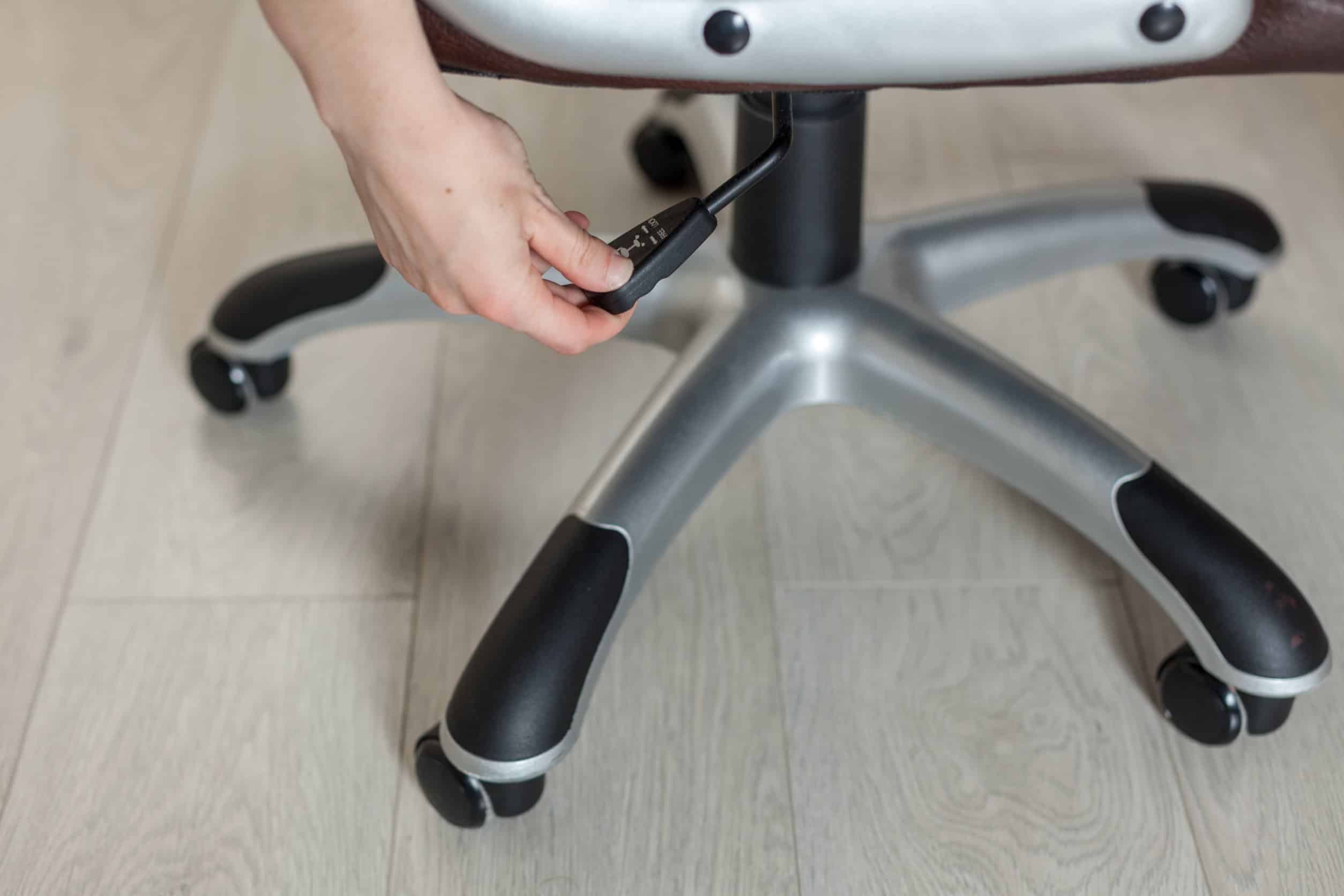Almost everybody who’s ever used an office chair knows what the height adjustment lever does. It’s a feature that’s become a standard for all office chairs, after all. However, setting your chair to just the right height is much more important than you might think.
This is why in today’s post, we’ll tell you all about how to make your chair higher, even if it doesn’t have a lever, and how to set it to your body height. Then, we’ll close out by giving an overview of what chair ergonomics are all about, and how they can help you.

How to Make an Office Chair Taller: Our Solutions
We’re aware that raising your office chair can be as simple as pulling a lever that’s located under your seat. However, most people don’t know what the ideal height for their chair is. If you’re sitting in a chair with height adjustability function and are still experiencing chronic back pain, you might benefit from our first solution.
Let’s start by explaining how to make a desk chair taller using the lever that’s under the seat, and we’ll also tell you how to adjust it to your own height.
Use The Lever
This may seem obvious, but it can’t hurt to give it a try. If there isn’t a lever under the seat, it might be located somewhere else, like the back of the chair, but this is very rare.
In some cases, you may be unable to find a lever at all, but don’t worry. A chair that doesn’t feature a lever can still be height adjustable. Although they are very rare nowadays, old chair models utilize a different type of mechanism to lift the seat.
These chairs are called screw-lift chairs, and you can raise and lower them by turning the mechanism. Some of these chairs may feature a knob under the seat, which you can turn to adjust your chair’s height.
Alternatively, some models don’t feature any knobs or levers but can be adjusted by turning the seat itself. To find out which way you need to turn the chair to raise it, you can simply take a look under the seat. You’ll most likely find two arrows that indicate which way to turn the chair to raise it and vice versa.
Replace the Gas Lift Cylinder
If you can raise your chair, but are still unsatisfied with the maximum height it reaches, you can easily replace the gas lift by yourself. The key here is to find out the maximum height of your current cylinder, and then you can find one with a higher range.
Considering most office chairs use a gas lift that’s about 13-14 cm (5.5 inches), you can’t go wrong with anything that’s taller than that. You can easily find a new gas cylinder that can go up to 20 cm (8 inches) online and they’re usually pretty affordable.
Once you find a gas cylinder that’ll fit your needs, it’s fairly easy to replace them. All you need are the right tools and a little bit of confidence.
How to Replace Your Chair’s Gas Lift Cylinder
To start, turn your chair upside down so the gas lift cylinder can move freely. To change your gas cylinder you’ll need:
- Hammer or a rubber mallet,
- A screwdriver,
- A pipe wrench, and
- A new gas cylinder.
Start by holding the cylinder with one hand while gently striking the base of the chair. You’ll need an upwards motion to loosen the cylinder’s base.
Once the chair base is off, you’ll need to use the pipe wrench and tighten it on the cylinder. Once the wrench is secure, twist it to loosen the cylinder from the seat and remove it. Alternatively, if this doesn’t work or if you don’t have a pipe wrench, you can use a screwdriver.
With your chair still upside down, locate the four screws at the base of the cylinder, right where it’s attached to the seat. Once you remove these screws with a screwdriver, you’ll be able to take the cylinder out with ease. Upon removing the old cylinder, you can install your new cylinder by following the same steps in reverse, which should be much easier to do.
Replace the Casters
If replacing your gas lift cylinder didn’t work and your chair is still not as high as you want it to be, you can replace another component of your chair, which are the casters.
The casters are the little wheels attached to the base of your chair and help you move around freely in your chair. Usually, the default caster size on most chairs is about 5 cm in diameter, which is about 2 inches. You can easily find larger casters online, and replacing them is a simple task you can do on your own. Let’s explain.
How to Replace Chair Casters
To change your office chair’s casters, you’ll need a rubber mallet, a screwdriver, and a spray can of the ever-reliable WD-40. In theory, you shouldn’t need any tools for this, as all you need to do is pull the old casters out and push the new ones in, but it can’t hurt to have a backup.
Start again by placing your office chair upside down. Try pulling the casters by hand first. They should come right off with a little force. If that’s not the case, you’ll need the screwdriver. Pull the caster out as far possible, then place the flathead screwdriver between the caster and the base of the chair. Use a prying motion to pull the rest of the caster out of the base.
Once you get all the casters out, it’s time to install the new ones. Installing new casters can be as easy as pushing them in place. Try pushing them until you hear a click: that’s how you know the caster is securely in place.
You may find that installing the new casters is even harder than removing them. This is because chair casters have a ring at the tip that holds them in place. This ring is what makes the clicking sound when installed correctly, and unused casters may have a larger ring that hasn’t been compressed yet.
If this is the case, spraying some WD-40 on the tip of the caster and using a rubber mallet to push it in place should do the trick.
Use a Drafting Stool Cylinder
This may sound a bit unconventional, but if you’re still not satisfied with the height range of your chair, you can try installing a drafting stool cylinder on your regular office chair.
Drafting stool cylinders can go much higher than a regular gas lift chair, and replacing them is as simple as replacing any other gas lift cylinder. However, since your chair will be much higher with this new cylinder, we also recommend getting a footrest ring. These may not be as easy to find as chair cylinders, but they’ll be well worth your while.
Use a Seat Cushion
Seat cushions aren’t exactly the way to go if you want to raise your chair significantly. However, if you only want to elevate yourself a few centimeters and are looking for a quicker and much more practical solution, this is it.
Seat cushions are very popular items and they can be found easily online. They come in a variety of different shapes to fit different needs. You can even find cushions that are made specifically to alleviate conditions such as chronic back pain and sciatica.
If you’re working in a particularly warm environment, you can also find ones that have infused gel layers. These gel-layered cushions wick the heat away and provide a cooling effect. Therefore, if sweating is a problem for you, you’ll kill two birds with one stone.
Ergonomics Explained
By definition, ergonomics is a field that studies the efficiency of people’s work environments. It’s an important topic that shouldn’t be overlooked, and even learning the basics can help you a lot. With just a few minor adjustments, you can easily optimize your work efficiency, and the height of your chair is where you should start.
As we mentioned above, the height of your chair should be set according to your body height. This isn’t ideal if your chair is too high and your feet are dangling off the chair. Your body partially relies on your feet for the support it needs, and taking this support away might stress your spine too much. You may even notice an unusual tenseness in your hips and upper legs if you sit like this.
On the other hand, if your chair is set too low, you may find yourself tucking your legs underneath you, or sitting cross-legged. According to studies, this may cause an imbalance in your spine and pelvic muscles, leading to posture-related problems. Therefore, setting your chair height just right is the way to go, which we explained in one of our previous posts, but what else should you consider?
Lumbar Support
The lumbar region is located right above your tailbone. It’s the inward curve that’s in your lower back, and this area needs a lot of support, especially if you’re sitting for long hours. Giving your body proper lumbar support can help you sit up straight and maintain good posture, and it can also alleviate back pain.
Most office chairs provide internal lumbar support with the help of an adjustment knob, but some models like gaming chairs do this with an external pillow. A lumbar pillow is a small detachable pillow that you can adjust using the straps. It can be simply shaped like a tiny pillow, but some more advanced chairs provide orthopedic pillows that are shaped to fit your lower back.
If you want to learn more about how a gaming chair can help your posture, you can check out our post where we talked about postural health and gaming chairs.
Armrests
Another feature that’s often overlooked is the armrests. Can you believe that some chairs don’t even have them? Armrests are an important part of a chair, especially if you’re going to be sitting for long periods of time.
An armrest can help support your body, relieve the stress off your shoulders, and it can even help you sit up straight. While a lot of chair models feature armrests, some models offer adjustable ones. Armrest adjustability is usually described with an indicator such as 2D or 3D, which refers to the directions you can adjust them in.
If you’re experiencing back pain or shoulder tenseness, going for a chair with 4D armrests is a great idea. A good example of a good quality chair with 4D armrests is the X Chair X4, which we previously reviewed.
Backrest
Backrests are an essential component of every office chair. A good backrest can let you lean back and rest your spine while you’re working without worry. It supports your entire back and spine, and some chairs even provide neck support with a high backrest. While most classic office chairs have low-profile backrests, some models offer a high-profile back that includes a neck pillow.
If you’re experiencing neck pain and looking for a chair with a high backrest and good neck support, you can check out our buying guide for the best chairs for neck pain.
Additionally, a good backrest should allow you to recline your seat to your liking. While we’re on the subject, we should note that sitting upright doesn’t actually mean a 90-degree thigh-body angle. Ideally, you should recline your seat 10 to 30 degrees past the right angle. This is what Cornell University’s Ergonomics department suggests. Sitting at a reclined angle will help your sit upright much more easily, and it’s also healthier for your spine.
Conclusion
As we conclude our guide, let’s take a recap of the main things we’ve covered. As we said, raising your chair can be as simple as adding a cushion under you. However, you can get much more satisfying results if you’re willing to make a little more effort.
If using the lever doesn’t work, changing your gas lift cylinder or the casters can be a simple yet effective solution. You can even install a drafting chair lift to your regular chair, but it’s recommended to add a footrest if that’s the case.
Even if you think that you’re satisfied with your chair’s height, it may still not be the ideal height for you. If your feet are dangling off the chair or you are tucking your legs underneath, you may want to adjust the settings.
Lastly, let’s end our post with a reminder that chair ergonomics are vital if you’re sitting for long periods of time. Therefore, having good lumbar support, armrests, and a backrest is as important as setting your chair height correctly.





